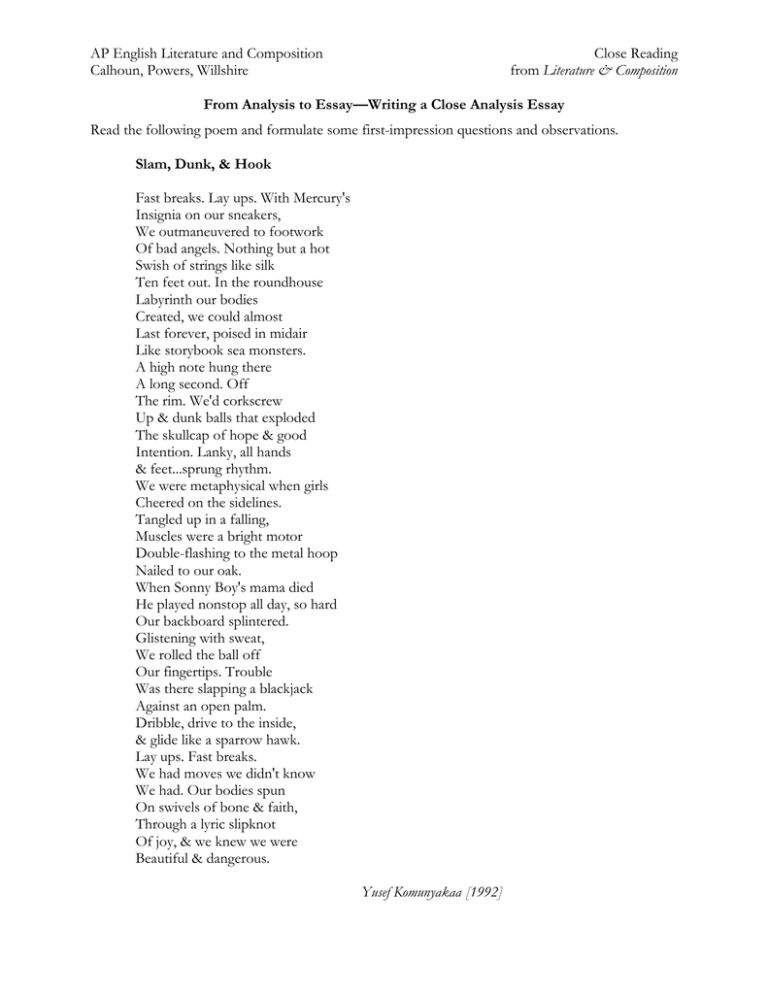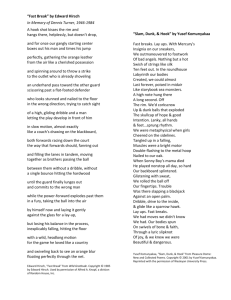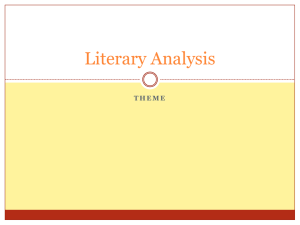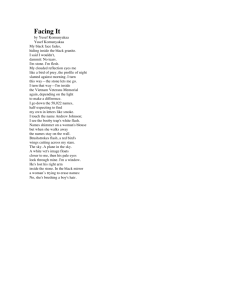AP English Lit Close Reading: Poetry Analysis
advertisement

AP English Literature and Composition Calhoun, Powers, Willshire Close Reading from Literature & Composition From Analysis to Essay—Writing a Close Analysis Essay Read the following poem and formulate some first-impression questions and observations. Slam, Dunk, & Hook Fast breaks. Lay ups. With Mercury's Insignia on our sneakers, We outmaneuvered to footwork Of bad angels. Nothing but a hot Swish of strings like silk Ten feet out. In the roundhouse Labyrinth our bodies Created, we could almost Last forever, poised in midair Like storybook sea monsters. A high note hung there A long second. Off The rim. We'd corkscrew Up & dunk balls that exploded The skullcap of hope & good Intention. Lanky, all hands & feet...sprung rhythm. We were metaphysical when girls Cheered on the sidelines. Tangled up in a falling, Muscles were a bright motor Double-flashing to the metal hoop Nailed to our oak. When Sonny Boy's mama died He played nonstop all day, so hard Our backboard splintered. Glistening with sweat, We rolled the ball off Our fingertips. Trouble Was there slapping a blackjack Against an open palm. Dribble, drive to the inside, & glide like a sparrow hawk. Lay ups. Fast breaks. We had moves we didn't know We had. Our bodies spun On swivels of bone & faith, Through a lyric slipknot Of joy, & we knew we were Beautiful & dangerous. Yusef Komunyakaa [1992] A Sample Close Analysis Essay Read the sample essay, and respond to the questions at the end. Carlton Curtis AP English Literature and Composition Ms. Calhoun Period 3 August 30,2014 The Beauty and Danger of Basketball In “Slam, Dunk, & Hook,” African American poet Yusef Komunyakaa moves from a description of the physicality of basketball to a philosophical reflection on the lives of the players. Written in terse lines, this poem embodies the energy of young athletes on the court, set against the stark backdrop of the society they live in. Vivid images, classical allusions, and metaphors characterize the game that is both escape and transcendence for its players. “Slam, Dunk, & Hook” is an exaltation of the sport of basketball and the force of the rhythm, power, and grace it inspires in its players. The beginning lines describe the motion of shots in basketball as swift and beautiful, ballet-like maneuvers, yet the short lines pulse with their own energy, conveying the steady beat of a basketball being dribbled down the court or maybe even a drum beat. By using a fragment such as “Nothing but a hot / Swish of strings like silk / Ten feet out,” Komunyakaa lets an image replace the measured thought of a full sentence. That image captures the quick movement and vitality of the players as they take their best shots. Enjambment, such as “A high note hung there / A long second,” suspends the moment in time, making the reader part of the “long second.” In fact, Komunyakaa ends several lines in midair, as it were, giving a feeling of the players being in flight. They “could almost / Last forever, poised in midair,” they “corkscrew / Up,” and they “feint, / & glide.” Even the ampersand that replaces the word “and” suggests motion and speed. The poem flows with exuberant motion, captured in verbs such as “corkscrew,” “exploded,” “tangled,” “splintered,” and “Double-flashing.” Komunyakaa emphasizes the sheer physicality with images such as “the roundhouse / Labyrinth our bodies / Created.” These players are “All hands & feet…sprung rhythm”; they sweat and dribble. The comparisons created by similes and metaphors emphasize their power. They “glide like a sparrow hawk,” their “Muscles were a bright motor / Double-flashing,” and their “bodies spun / On swivels of bone & faith.” That last image, combining both concrete and abstract words, is a reminder that this game is more than just basketball to them. The classical allusions to Mercury, a labyrinth, and sea monsters suggest that these players become more than just kids on the street. Although the reference to Mercury—the Roman messenger of the gods—starts as an actual insignia on a player’s sneakers, the symbol also associates the players’ movement with speed, flight, and purpose. They are imbued with a mythical power, an epic sensibility, and are frozen in time with their youthful beauty intact: “we could almost / Last forever, poised in midair / Like storybook sea monsters.” They become so swift that they can “outmaneuver[ed] the footwork / Of bad angels.” The speaker sums up the mythical power of the players on the court when he says, “We were metaphysical when girls / Cheered on the sidelines.” They transcend their physical and perceived limitations and play as the chorus of fans lifts them to a higher state of being. They may not be gods, but they have mythic possibilities. Yet they are not all grace and beauty. The struggle on the basketball court develops as a metaphor for the lives of these players, trying to “outmaneuver[ed] the footwork / Of bad angels.” The description of muscle and movement gives way in the second half of the poem to a passage about the death of Sonny Boy’s mother, a loss he copes with by escaping to the court: “He played nonstop all day, so hard / Our backboard splintered.” Sonny Boy’s crisis, the speaker seems to be saying, is not the exception because “Trouble / Was there slapping a blackjack / Against an open palm.” Trouble is part of the lives of these young men, who play with a powerful intent in their hearts, the intent to defy the limitations of their bodies and the limitations of their fortunes as young black men in America. They vent their frustrations on the steel rims and backboards of street ball courts and dream of breaking whatever boundaries that personified “Trouble” brings. The game of basketball is a release for the players in the poem, whether from the perceived limitations of their youth or perhaps racial or economic barriers. The young men lose themselves on the court, wishing to manipulate their lives as effortlessly as they do the ball. They know they must fight to soar and excel beyond their station of second-class citizens. In the end, the game is not just an escape but an exercise in transcendence, where the stakes are control, freedom, and possibility. The intensity and concentration of losing themselves in basketball becomes a “lyric slipknot / Of joy.” These young men are not only confident but also menacing in the knowledge that they are both “Beautiful & dangerous.” Questions 1. Examine the relationship between the thesis and the topic sentences. Do you think the basic structure of the essay is effective or ineffective? Why? 2. How does the essay support its argument with evidence from the text? Cite a paragraph that you find especially effective and explain why. 3. What is another argument you might make based on a close reading of “Slam, Dunk, & Hook”? It does not have to contradict this student’s interpretation entirely but rather offer another way to read the poem or a different conclusion than the one drawn in this sample essay. Read the following poem by Edward Hirsch. Then use one of the close reading techniques you’ve learned to generate ideas for a thesis statement and several topic sentences for a close analysis essay. Fast Break In Memory of Dennis Turner, 1946-1984 A hook shot kisses the rim and hangs there, helplessly, but doesn’t drop, and for once our gangly starting center boxes out his man and times his jump perfectly, gathering the orange leather from the air like a cherished possession and spinning around to throw a strike to the outlet who is already shoveling an underhand pass toward the other guard scissoring past a flat-footed defender who looks stunned and nailed to the floor in the wrong direction, trying to catch sight of a high, gliding dribble and a man letting the play develop in front of him in slow motion, almost exactly like a coach’s drawing on the blackboard, both forwards racing down the court the way that forwards should, fanning out and filling the lanes in tandem, moving together as brothers passing the ball between them without a dribble, without a single bounce hitting the hardwood until the guard finally lunges out and commits to the wrong man while the power-forward explodes past them in a fury, taking the ball into the air by himself now and laying it gently against the glass for a lay-up, but losing his balance in the process, inexplicably falling, hitting the floor with a wild, headlong motion for the game he loved like a country and swiveling back to see an orange blur floating perfectly through the net. Edward Hirsch [1985] Working With Two Texts: The Comparison and Contrast Essay TITLE SITUATION SPEAKER (POV) RHYTHM & METER FORM SYNTAX FIGURATIVE LANGUAGE “Slam, Dunk, & Hook” “Fast Break” A Sample Comparison and Contrast Essay Following is a sample essay that follows the element-by-element form of comparison. Read it, and then discuss the questions that follow. Talat Rubin AP English Literature and Composition Ms. Calhoun Period 3 August 30,2014 One Game, Two Lives There are many different types of streets in our world, some paved with gold and others with potholes. In the poems “Fast Break” by Edward Hirsch and “Slam, Dunk, & Hook” by Yusef Komunyakaa, each poet captures the essence of the game of basketball and its meaning to the players they depict. While the only piece of equipment needed is a hoop and a ball, the manner and tone of each game differs from community to community. Indeed, the manner of playing in the community of each poet is quite different. I fear that the players in Komunyakaa’s “Slam, Dunk, & Hook” would make mincemeat out of Hirsch’s players in “Fast Break.” In these two poems, the point of view, images, and rhythmic structure reveal the relationship between the players and the sport they love, but a world of difference separates the experience of basketball for each of the speakers. Though both poems are told from a first-person point of view, the speakers are connected to the game in different ways. Hirsch’s speaker seems to be observing as a reporter, a member of the audience. Yet the description of “our gangly starting center” makes it sound as if the speaker is on the team himself and right in the action. Told in the present tense and described moment-bymoment, this perspective adds excitement to the poem because we feel that we’re with the speaker, watching the action unfold. In contrast, Komunyakaa’s poem is written as the memory of past events. “We outmaneuvered,” he recalls; “we could almost / Last forever,” he reflects, and “we knew we were / Beautiful & dangerous.” The speaker’s tone indicates an experience that he has considered and examined. The fact that he remembers so vividly and intensely emphasizes the lasting importance the game had (or has) for him. While the two poets use syntax in a different manner, in both cases it establishes a rhythm that reflects the pace of the game. In Komunyakaa’s poem, sentence fragments along with the abundant use of periods and commas within sentences emphasize the poem’s truncated beat, which could be the beat of a basketball bouncing off the court, or the heartbeat of the players in excited motion. The abrupt and short lines suggest a combative and harsh pace. In contrast, Hirsch’s poem is one long sentence divided into couplets through enjambment, creating a fluid rhythm to express the grace in this one continuous play. The long sentence, consisting of multiple clauses and descriptive phrases, suggests that this poem, like the play, is a team effort dependent on many small parts. The different syntax of these poems defines the rhythm of two different games. The diction and imagery reflect the meaning of the game of basketball to each speaker. Hirsch’s words have positive connotations: “kisses,” “cherished possession,” and “together” demonstrate his sense of companionship that is fostered in the sport. They are not mere fellow team members, but “brothers” who share a common purpose. This point is made explicit when the speaker refers to the forward who is playing “the game he loved like a country.” Komunyakaa’s word choice reflects the energy and anger expended during the game. The players are not merely young men—they are almost god-like, with “Mercury’s / Insignia on [their] sneakers.” Komunyakaa evokes the shattering of a young man’s emotional core when the “backboard splintered” in his attempt to forget about the loss of his mother. The language expresses the aggressive manner in which they play, as well as the society they come from. It is an aggressive game where even their graceful motions have violent undertones—they “glide” not like sparrows, but like “sparrow hawk[s]”. Yet while Komunyakaa’s basketball is a more physical demonstration of the game than Hirsch’s, the same vitality of spirit can be found in each poem. Like Komunyakaa’s players who “rolled the ball off [their] / Fingertips,” Hirsch’s lay the ball “gently / against the glass.” These two poets create different visions of their world and game by the imagery they employ. Hirsch creates a gentler, more tender image as a “hook shot kisses the rim.” In contrast, Komunyakaa uses imagery of war, power, and brute force: the players are alternately “storybook sea monsters,” birds of prey, and boys with god-like speed. Basketball was not merely a game to the speaker in “Slam, Dunk, & Hook,” but a battle, similar, we can assume, to the one he waged outside the court. In their poems, Edward Hirsch and Yusef Komunyakaa describe the physical dimensions of the sport of basketball. In doing so, they not only articulate the meaning of a moment of time in their players’ lives, but also expose the world in which they live. Komunyakaa’s game has its origin on the streets, and his diction demonstrates the roughness of those streets, while Hirsch’s graceful depiction of the sport demonstrates a more benign view of the world. For Hirsch, the game is a beautiful complement to life. For Komunyakaa, it is the battle that is life. It is clear that the poets come from different neighborhoods, different communities, and most likely different time periods. But what is even clearer is the manner in which this simple game, with a round ball, touched and shaped their lives. Questions 1. Is the introduction effective? Explain why or why not. If you believe it is not effective, how could it be improved? 2. Why are there two separate paragraphs for the analysis of imagery? Explain whether you think that dividing the analysis into two paragraphs was a good decision. 3. In what ways are transitions used within this essay to emphasize the similarities and differences between the poems? 4. Do you agree with the essay’s argument? Explain why or why not. Which parts of the interpretation do you find most persuasive? questionable? 5. What other literary elements might you have used to make a similar argument? 6. What suggestions can you offer for polishing the essay?







